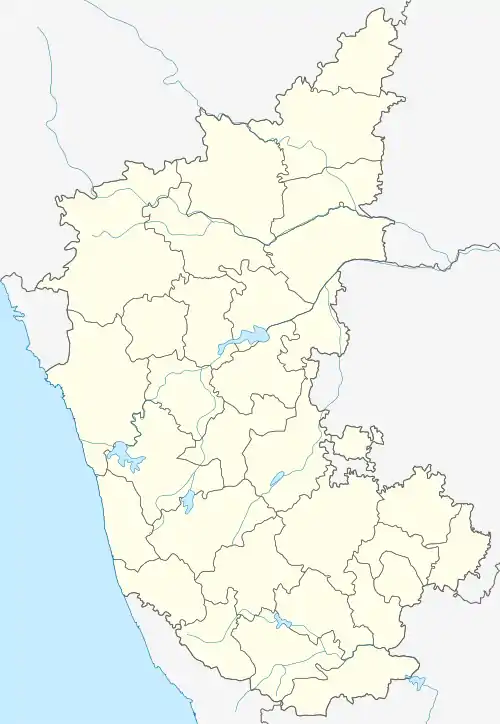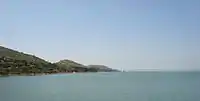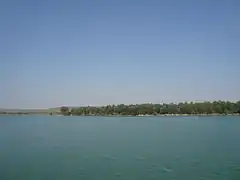Saundatti
Saundatti also known as Savadatti (in Kannada)[1] is one of the oldest towns in Belgaum district in the Indian state of Karnataka. It is a celebrated pilgrimage centre located 78 kilometres from Belgaum and 37 kilometres from Dharwad. Savadatti is also the name of the taluk (sub-district), which was previously named Parasgad. There are several ancient temples in Saudatti.
Savadatti
Savadatti | |
|---|---|
town | |
 Savadatti Fort | |
 Savadatti Location in Karnataka, India | |
| Coordinates: 15.7833°N 75.1167°E | |
| Country | |
| State | Karnataka |
| District | Belgaum district |
| Area | |
| • Total | 16 km2 (6 sq mi) |
| Elevation | 610 m (2,000 ft) |
| Population (2011) | |
| • Total | 38,155 |
| • Density | 2,384.69/km2 (6,176.3/sq mi) |
| Language | |
| • Official | Kannada |
| Time zone | UTC+5:30 (IST) |
| PIN | 591 126 |
| Telephone code | 08330 |
| ISO 3166 code | IN-KA |
| Vehicle registration | KA-24 |
History of Rashtrakuta kings
The historical name of the Savadatti was Sugandavarti "Sougandipura". It was the capital of the Ratta dynasty (from 875-1230), until the capital shifted to Belgaum.[2]
- During the twelfth and thirteenth centuries, Belagaon (Belgaum)[3] was the capital of the Rattas, the chieftains of Saundatti. The fort at Belgaum was built by Bichiraja (Ratta Dynasty) in 1204.
- The Ratta clan was one of several names of the Rashtrakuta Dynasty.
- Rattas of Saundatti accepted[4] the overlordship of Taila II (AD 973-977).
- Two of the pillars at Belgaum fort have Kannada inscriptions in Nagari script, one inscription from around 1199 is attributed to the Ratta king Kartaveerya IV.
Rattas (Rashtrakutas) suryavanshi kingdom
- In one of the inscriptions related to Rattas of Saundatti it is mentioned that Krishna III having appointed Prithvirama[5] as a chief feudatory had dignified the Ratta dynasty of Saundatti.
- The Rattas of the saundatti, who were used to represent themselves as lords of the Lattaluru[6](present day Latur), could have represented their ancestor as Manyakheta pua var adhisvara if they wanted to avoid Lattalura pura var adhisvara.
Inscriptions
- At Saundatti, Jain inscription slab written in Sanskrit and Kanarese (Kannada)[7] of Krishna Rashtrakuta, Shaka 797 (c. 875 AD), and Vikramaditya, Shaka 1017 (c. 1095 AD).
- At Saundatti, in front of the Western Chalukya-style Ankeshwara temple, there is an inscription carved into the wall by the Ratta Chief Ankarasa.
Jainism
- The Rattas of Savadatti are Jains[8] by religion.
- In the 11th century Rattas of Saundatti and their provincial governors were great patrons of Jainism.[9] Kartivirya's son, a Jain saint Munichandra, a minister to Laksmideva and a teacher, and has the title of Acarya, the founder of Ratta-rajya.
- Savadatti has two small Jain basadis dating back to Ratta times.
Tourism





Savadatti fort
18th century Savadatti fort was built by the Sirasangi Desai with 8 bastions. Savadatti fort has a Kadasiddheshwara temple, surrounded by four bastions. Around the Kadasiddheshwara temple in the inner chajja of the prakara there is a row of carvings of geometrical patterns with over two hundred designs, some painted.
Renuka Saagura
Renuka Saagura is a reservoir by the Malaprabha River adjacent to Saundatti, formed by the Naviluteertha Dam. The name Renuka Saagura is because of the Renuka (Yullumma) temple at Yullummagudda, Saundatti.
Yallammanagudda
The temple of the goddess Yellamma or Shree Renukadevi, is a pilgrimage site for Shakti devotees. Every day, hundreds of pilgrims visit the temple. The congregation is especially large, crossing the one million mark, on two auspicious days in the year - Banada Hunnime and Bharatha Hunnime. The century-old temple of Yellamma is situated atop Yellammanagudda, amidst the picturesque Ramalinga Hills, about 5kmsfrom Saundatti. Between Saundatti and the temple is the magnificent fort of Paarusgad, dating back to the 10th century.
Naviluteertha
The Renuka Saagura, formed by the Naviluteertha Dam, touches the low-lying areas of Saundatti. There is a spot called Jogullabhaavi here, where there is a temple. Pilgrims take a holy dip here before visiting the Yullumma hill. This Sumaadhi (grave) is in the Raamaapur area of Saundatti.
Shirasangi Shri KalikaDevi Temple
Shirasangi a small village located approximately 25 kilometers from Saundati is famous for Shri Kalikadevi temple. The temple is known to be very ancient and is believed to be the place where Shringa maharishi worshiped Shri Kalikadevi. Shirasangi is also known for Shri Tyagveera Lingaraja Desai. Shri Lingaraj was one of the main donors to give land to K.L.E Society.
Savadatti Temples
The town has temples dedicated to Ankeshwara, Puradeshwara, Nagarkere Mallikarjuna, Veerabhadra, Ulvi Basavaeshwara, Mouneshwara, Dyamavva and Venkateshwara, which is the largest.
Puradeshwara temple
The Puradeshwara temple in the later Chalukya style is a trikutachala with three ardhamantapas, a common navaranga and two mukhamantapas. Gurlhosur Chidambar temple is also an historical temple. All three garbhagrihas with pierced windows have shivalingas. The shikhara, now damaged, over the central garbhagriha is in Kadambanagara style and the navaranga pillars are lathe-turned. Inside the niches of the navaranga are images of Parvati and Veerabhadra. This temple has been renovated very crudely. On the day of Ugadi, the rising sun's rays fall directly on the main shivalinga. The outer walls have fine sculptures depicting Hindu mythology and there are inclined chajjas all round. The open mukhamantapa, a later addition, is also in the same style with massive pillars.
Ankeshwara temple
The Ankeshwara temple in Desaigalli, built by Rattas in 1048 is in the Western Chalukya style and is below the ground level. There are steps descending to the mukhamantapa. In front of the temple, there is an inscription carved into the wall by the builder, Ratta Chief Ankarasa.
Gallery
 Savadatti Fort
Savadatti Fort Savadatti Fort
Savadatti Fort Savadatti Fort
Savadatti Fort
See also
References
| Wikimedia Commons has media related to Saundatti. |
- "Savadatti". Retrieved 18 March 2009.
- "Chapter XIV, Karnataka, The Tourist Paradise". Archived from the original on 4 March 2009. Retrieved 18 March 2009.
- "Belgaum". Retrieved 18 March 2009.
- Sen, Sailendra Nath (1999). Ancient Indian History and Civilization By Sailendra Nath Sen. ISBN 9788122411980. Retrieved 18 March 2009.
- "The Rattas (Rashtrakutas) of Saundatti". Retrieved 18 March 2009.
- Sircar, Dineschandra (1971). Studies in the Geography of Ancient and Medieval India By D. C. Sircar. ISBN 9788120806900. Retrieved 18 March 2009.
- "Jain Stone with inscription [ Saundatti ]". Retrieved 18 March 2009.
- "JAINISM IN SOUTH INDIA". Retrieved 18 March 2009.
- "Kollapur District Gazetteer, JAINS". Retrieved 18 March 2009.
On can get more info, from the http://karnatakatravel.blogspot.com/ (which I do often).
